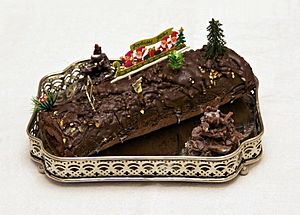Yule log (cake) facts for kids

A traditional Yule log (bûche de Noël) made with chocolate filled with raspberry jam.
|
|
| Course | Dessert |
|---|---|
| Place of origin | France |
| Main ingredients | Genoise or other sponge cake, chocolate buttercream, or other icing |
A Yule log cake, also known as bûche de Noël (pronounced "boosh duh noh-ELL"), is a special Christmas cake. People often eat it as a dessert around Christmas time. It's very popular in countries like France, Belgium, and Switzerland. You can also find it in places that used to be French colonies, such as Canada, Vietnam, and Lebanon.
This yummy cake is also enjoyed in the United States, United Kingdom, Portugal, and Spain. It's made from sponge cake and shaped to look like a small, real Yule log. Think of it as a sweet roulade, which is a cake that's rolled up.
Contents
What is a Yule Log Cake?
The Yule log cake is a delicious treat that looks like a tree branch or log. It's a fun way to bring a bit of nature indoors during the winter holidays. The cake is usually covered in chocolate or other icings to make it look like tree bark.
How it's Made
The Yule log cake first appeared in the 1800s, probably in France. It then became popular in many other countries. It's traditionally made using a type of sponge cake called genoise. This cake is baked in a large, flat pan, similar to how a Swiss roll is made.
Once the cake is baked, it's covered with icing and then carefully rolled up into a cylinder shape. After rolling, more icing is put on the outside. The most common kind of Yule log cake uses a plain yellow sponge cake with chocolate buttercream. However, there are many different kinds! Some use chocolate cake, a rich chocolate cream called ganache, or icings flavored with espresso coffee or special liqueurs.
Decorating Your Yule Log
Yule logs are often decorated to look even more like a real log. Sometimes, one end of the cake is cut off and placed on top or sticking out from the side. This makes it look like a chopped-off branch.
To make the icing look like tree bark, people often drag a fork through it. This creates a rough, wood-like texture. A sprinkle of powdered sugar on top can make it look like fresh snow. Other fun decorations can include small, real tree branches, fresh berries, or cute mushrooms. These mushrooms are often made from meringue (a sweet, light foam) or marzipan (a sweet paste made from almonds).
History of the Yule Log Cake
The name bûche de Noël originally referred to the actual Yule log. This was a large log that families would burn in their fireplace during the winter holidays. Over time, as people stopped burning Yule logs as much, the name was given to the dessert instead. We can find mentions of the cake as bûche de Noël or Yule Log in English from at least the early 1900s.
Gallery
See also
 In Spanish: Tronco de Navidad (postre) para niños
In Spanish: Tronco de Navidad (postre) para niños






